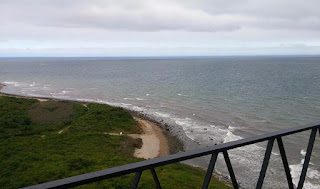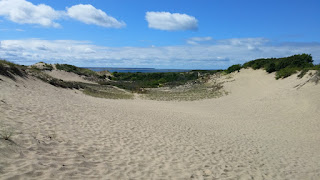Exploring Montauk Point Lighthouse
by Meg Carr
If you’re looking to visit a monument that encompasses a lot of Long Island’s history at one site, or in need of a killer quad workout, the Montauk Lighthouse is a great choice. Built in 1796, the lighthouse was originally commissioned by George Washington. The jagged geography of Montauk’s coast and its location relative to the important shipping port of New York City made it a prime location for a lighthouse.
 |
|
Photo #1-Montauk light and the attached living quarters, which now house a museum.
|
Montauk Point Light was lit using candles for nearly 150 years until converted to electric power in 1940. It was not until 1987 that the lighthouse became fully automated, meaning that it no longer required a keeper to light or extinguish the lamp. At night, lighthouses can be distinguished using their unique light pattern (how many seconds between revolutions). During the day, sailors can determine their location by looking at the shape of a lighthouse and the way it is painted.
 |
| Photo #2-Upon climbing to the top of the lighthouse, visitors are rewarded with a stunning view. On clear days, you can see Block Island and the Connecticut shoreline. (Photograph by Haena Lee) |
During World War II, Montauk Light and the surrounding area became a military base known as Camp Hero. The military buildings were disguised to resemble a “quiet fishing village”, but peeking in the window, you might catch a glimpse of scores of drawings of enemy ships on the walls. At the time, Camp Hero housed the most powerful guns in the world. Whether you’re a history buff or just want to spend some quality time near the ocean, the Montauk Pt. Lighthouse Museum is a great place to explore.
Erosion at Montauk Point
by Marissa DeBonis
Today, we visited Montauk Point. Although I grew up on Long Island, I realized that I knew very
little about the history behind the Montauk Lighthouse. Built in 1796, the Montauk Lighthouse was the first lighthouse in New York and only the fifth lighthouse in the United States. It was originally constructed between three hundred and four hundred feet from the shoreline. Today, it is located only about one hundred feet from the shoreline. That’s a loss of over two hundred feet in two hundred years! The planners of the Lighthouse knew that something like this would happen…all thanks to this thing called erosion. Erosion is the carving away of the sediment and rocks do to forces such as wind and water. The waves of the Atlantic Ocean have been slowly chipping away at Montauk Point for hundreds of thousands of years.
It was no secret that erosion was, and still is, an issue for the future of the Montauk Lighthouse.
That’s where Giorgina Reid, the “pioneer of erosion control,” steps into play. In the 1960’s, Reid developed a plan to help slow down the effects of erosion on Montauk Point. She developed a technique called “Reed-Trench Terracing.” Large boulders were placed at the seawall in order to decrease the effects of the waves on the shoreline. In order to stabilize the slope of the shoreline, terraces and vegetation were put into play. The lumber and steel boxes, or terraces, were created on an angle and vegetation was planted in them. This was successful in reducing the impacts made by groundwater runoff. Reid’s terrace idea is still in effect today, slowing down the disappearing act of Montauk Point.
The “Walking Dunes”
by Haena Lee
Not far from Montauk Lighthouse stands the most fascinating dune area of Long Island, the “walking dunes.” The dunes here are called the “walking dunes” because of the strong northwest winds cause the dunes to “walk”. The winds move the 80 feet tall dunes about 3.5 feet each year. As they “walk,” the dunes buries a forest underneath and it is only a matter of time before the entire forest is covered. Who knew dunes could walk?
The “U” shape of the dunes holds the Phantom Forest in the middle. The Phantom Forest was once a forest that was covered by the walking dunes. This area was covered with pitch pine and oak but now stands dead tree trunks and bits of shrub. The area is protected to naturally restore the area, so don’t let your children play around this forest. This trail also has abundant poison ivy.

There are many “Habitat Restoration Project” signs near the Phantom Forest.
Over the walking dunes lies the beach of Napeaque Harbor. Some of my classmates and I saw a seagull with a strange hard shell in its mouth. I scared away the seagull as it dropped its shell on the floor. It was a whelk! At the end of the day, this seagull was not a very happy camper.

 On the left is the whelk, it was still alive and buried deep within its shell. The seagull on the right ventured out to find its lunch again.
On the left is the whelk, it was still alive and buried deep within its shell. The seagull on the right ventured out to find its lunch again.









